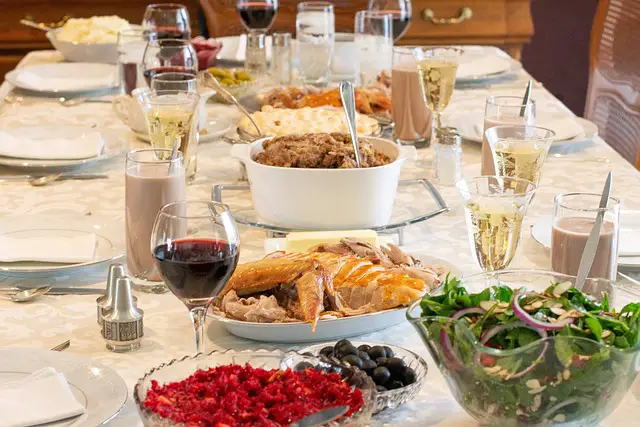Below, we’ve provided a list of potential ways to be more sustainable on Thanksgiving.
These tips and ideas cover various Thanksgiving activities and events, supplies & decorations, turkey & food, & even consideration for post Thanksgiving shopping.
Some tips and ideas may also be more practical than others, so, implement what is practical for you.
1. Consider The Potential Sustainability Impact Of Different Types Of Thanksgiving Activities & Events
There’s a range of activities and events that people may participate in or watch on Thanksgiving.
Some of these activities and events might include:
– Parades
– Watching sports, or playing your own sports
– Getting the family to participate in arts and crafts, and DIY activities
– Visiting a farm or ranch, like a Pumpkin Patch/Farm
– Doing a Thanksgiving run or stroll
– Giving thanks and gratitude
– Donating Thanksgiving meals, and other charitable deeds
From a sustainability perspective, it might be worth considering that:
– Some events might be more sustainable than others
Compared to some smaller events, some of the larger events, like the annual Thanksgiving Day parade held in New York, may be more resource intensive, and may result in several types of single use waste, from balloons, decorations, and other supplies
– Some activities might be more sustainable than others
For example, going for a walk, stroll or run, playing sports yourself, getting outside in nature, or generally having social get togethers that are lower or less excessive in terms of consumption, might be some of the more sustainable activities you can do on Thanksgiving
It might also be more sustainable to scale down the size of some activities or events you’d usually have some years
– Skipping Thanksgiving some years may be one sustainable approach
This can be controversial, as Thanksgiving is important to some people
But, some people that are single, some people without family at all or family close by, or some people that are otherwise busy or even working, will skip Thanksgiving day celebrations altogether some years, and do something else instead
2. Consider Reducing Use Of Single Use & Disposable Items & Materials
These single use and disposable use items and materials can include plastic cups, plastic plates, plastic cutlery, plastic food packaging, paper towels, and so on.
Instead, you might try to replace them with reusable items and materials where possible, such as cups, plates, cutlery, food containers, cloth towels, and so on.
Reusable and washable equipment may also be used in the kitchen when baking, cooking or preparing food for the day.
3. Consider The Sustainable Use Of Supplies & Decorations
There can be various supplies and decorations used for Thanksgiving, from ornamental turkeys and pumpkins, to lights, to lettering and signage, along with other supplies and decorations.
There might be several ways to use supplies and decorations for the day more sustainably.
We’ve listed those ways in a separate guide.
4. Be Mindful Of The Food You Eat
People should obviously eat what is safe and healthy for them individually.
But, from a general sustainability perspective, it might be worth noting that:
– Several reports indicate that turkey might be a more sustainable meat than a meats like beef and lamb in several ways
So, eating Turkey on Thanksgiving may not be the worst choice in terms of sustainability of foods
– Separate to the type of meat, reducing total meat intake may be sustainable in some ways
As one example, substituting some meat intake and substituting it with more sustainable foods, like salad or some plant based food (like potentially mashed potatoes, sprouts, and so on), may lower the sustainability footprint of the meal you eat on the day
– Sourcing Turkey and other Thanksgiving foods from local suppliers may also be more sustainable than sourcing food that has had to be transported or shipped longer distances
For example, separate to Turkeys, pumpkins (for pumpkin pie) might be sourced from a local pumpkin farm or pumpkin patch
*Note – consult a health professional before making any changes to the foods you consume. This is general information only. It is not professional advice, or a substitute for professional advice.
5. Reduce Food Waste
Food waste and food loss is one form of waste from a sustainability perspective, and food waste in particular can happen on Thanksgiving.
Two ways to reduce food waste from Thanksgiving Dinner might be:
– Be mindful of the food you prepare, and try to prepare food that you know will be eaten (instead of preparing food in excess and it being not eaten)
– Collect and store leftover food in reusable/washable food storage containers, so it can be eaten later
6. Dispose Of Waste Properly
Particularly when hosting Thanksgiving at your home, make sure to dispose of waste properly
This might involve collecting and disposing of general waste in the general waste bin
It might also involve collecting recyclable waste like bottles and cans and putting them in the recycling bin
7. Consider The Sustainability Of Black Friday, & Post Thanksgiving Shopping
Post Thanksgiving shopping usually involves shopping on Black Friday and on other dates where shopping deals and discounts are offered to consumers.
We’ve put together a separate guide about the potential sustainability impact of Black Friday, Cyber Monday, & the post Thanksgiving shopping period.
It might be worth considering how much consumerism and overconsumption plays a role in your own shopping habits, or whether you’re genuinely buying things you need for a good price during post Thanksgiving shopping.
Sources
1. Various ‘Better Meets Reality’ guides
','' ); } ?>